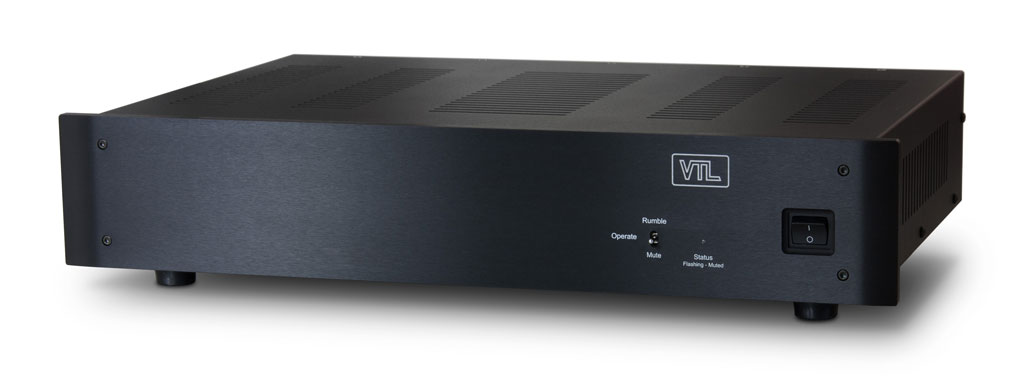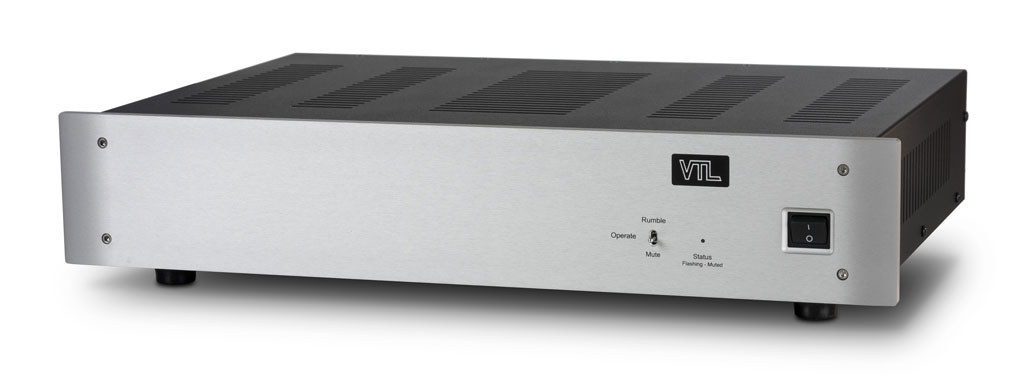The Article
VTL TP-2.5 Series II phonostage: Back to Basics
3rd June 2015

Aimed at the upper end of the budget market, Paul Rigby reviews the new VTL TP-2.5 Series II phonostage
So whatever happened to the TP-2.5 Series I? This early design lacked the functionality of this new model. The Series I offered no gain or load variations. In fact, the Series II is quite a departure, being more of a trickle down project, a simplification of the more expensive TP-6.5 (£8,350).
Luke Manley, VTL owner and Manager of Engineering for the outfit, sees this new valve design as a target for younger users eyeing the upper budget bracket, who have just discovered vinyl and might be considering cheaper, smaller, low maintenance solid state variants, “A valve phonostage presents an organic sound,” he said. “Less expensive solid states can sound quite grainy.”
Manley understands the pull of solid state but believes that valves offer an analogue solution. He also believes that serious valve-based dealers put more effort into customer support, “Dealers that care enough to carry valves tend to care enough to do a good turntable set-up,” he said.
The rear of the TP-2.5 chassis, spanning 482 x 355 x 95mm and weighing in at 11kg, features standard phonostage connections with a removable power lead and bespoke sockets, “They are mounted straight to the chassis,” said Manley, “and the PCB hangs off those. Stresses are removed because you are not pushing on the board or waiting for the jacks to fall off from heavy cable overuse.”
VTL decided to fit basic feet to the chassis, cutting costs but also recognising user’s predilection to after-market products.
On the front of the chassis is a three-way switch featuring: mute, ‘operating’ and rumble cut, “We wanted to use a hard toggle switch to avoid using microprocessers to circumvent noise getting into the phono signal.”
The rumble option is aimed at those playing warped records, cutting the bass response, “Some people don’t like to see their woofers move. They think it causes distortion in their power amp and maybe turntables of that price-point don’t have a substantial clamping system,” said Manley.
Opening the chassis means tackling a million screws, “That’s mainly chassis bracing. There’s a heavy toroidal transformer in there that could warp, so we braced it. We must have had a deal on screws that day,” said Manley.
Loading is changed via jumpers on the circuit board spanning: 100 Ohms, 250 Ohms, 470 Ohms, 1k Ohms, 4k7 Ohms and 47k Ohms over MC with 47k Ohms and 100k Ohms over MM. Specific loading can be achieved via your dealer, “If you have a cartridge rated at 473.56 Ohms, say, we can fit a resistor for that figure,” said Manley.
So why no DIP switch alternative? Manley agreed that it was technically possible to fit but the addition of extra wiring, possibly affecting the final sound quality plus the opening up of the chassis to possible RF (Radio Frequency) problems decided against it. RF shielding was a major concern for VTL, especially for those users living in big cities. The company offers a plug-in RF filter board for those with particular problems.
The guts of the phono amp runs ECC82 and ECC83 valves but the signal has to initially move through a JFET, “They are more like valves in terms of how they operate,” said Manley, “They are normally ‘On’ devices. They conduct as soon as you turn them on, so you don’t have to bias them. JFETs are an amplifier and you need high current to resolve the tiny cartridge distances in an MC cartridge. JFETs are also great for noise levels. All valve phonostages can produce noise, producing more than transistors. Using a JFET in the first stage, combined with our ECC82 (which has a good linear operating range) gives us a phonostage of around 20db amplification.”
Other jumper options include a switchable gain adjustment from 56db to 62db (there is some loss of top end with the latter) and an enhanced RIAA jumper, “Some people talk about a ‘fourth corner’ in RIAA instead of the three roll over points,” said Manley. “The fourth corner is supposedly there to make up for the cutter head continuously rolling off as it goes higher in frequency. I’m sure not about it, though, it sounds a bit forced in the top end to me.”
SOUND QUALITY
Sound testing began with Nina Simone’s title track from the 1971 album, ‘Here Comes The Sun’, which suffers from a measure of compression and excess vocal reverb so getting the best from it is a task for any phonostage. This choice was somewhat guided by the VTL. I couldn’t dip into my mono disc collection because the TP-2.5 has no mono/stereo switch.
Despite being rather hissy at higher volumes, the VTL allowed the song to progresses without undue rush or stress. The complex start to the song, for example, was easily tracked: the subtle bass guitar and piano sequence, the bell reverb that flowed into Simone’s low key finger clicks and then into drums is a sequence that can easily be muddled — the VTL exhibited no such problem. In fact, its easy going nature coaxed sprightly edges from the percussion while the intricate piano solo and secondary percussion exemplified the more than admirable tonal balance, imagery and instrumental separation. Each vocal sequence and instrument had its place within the soundstage, each given enough elbow room to allow the ear to fully recognise and appreciate the unique sonics. That said, the track was presented as a cohesive whole, no one frequency or instrument dominated. Most noticeable was the treble that was both delicate and informative, providing a refined playback that delighted. This jazz/soul interpretation had a particularly laid back ambience via the VTL.
Moving to the hard/prog rock of Byzantium’s self-titled album from 1972 (featuring future Blockhead, Chas Jankel) and ‘Flashing Silver Hope’, the first impression of this track was a great sense of focus that was exemplified by the lead vocal whose delivery was quite articulate and free from extraneous frequencies. Similarly, the electric guitar provided an admirable precision but there was a slight lack of involvement, despite the VTL’s admirable sense of clarity, which I quickly traced to a relative lack of weight and drive in the lower frequencies, compared to my Icon reference (that may lack a touch of lower bass grip but is inherently more musical in the rock firmament), which slightly subdued the carefree abandon of this hard rock track.
To further emphasise the point, I hooked up Avid’s Pellare phonostage and replayed the song. In contrast to the rather lengthy, feisty, sonic battle between the Avid and Icon phonostages, the Avid and VTL bout was over in Round One, emphasising the Avid’s powerful low frequency performance and that, despite making a good fist of it, the VTL does not quite excel at all musical genres.
Turning to the Wilson-Benesch turntable and classical, specifically Yehudi Menuhin’s ‘Mendelssohn & Bruch, Violin Concertos’, the VTL was on firmer ground. In this performance, Menuhin flew through an emotive performance. Firstly entering a wrenching, tormenting passion and then a plaintive pleading, a softening and a then an adamant conclusion. A series of sequences that Icon handled very well indeed.
Initially tackling the orchestral introduction, the backing strings, via the VTL, established an early, flowing atmosphere that sustained itself throughout the track, no-matter what the prevailing mood. Crescendos, meanwhile, added real urgency while the clean, clear upper mids offered a smooth presentation, which was affected by some hiss at higher volumes. During Menuhin’s solos, the sense of bow crashing and skidding upon violin was well conceived, there was a superb sense of imagery, giving the ear a picture of bow strings flying in close formation. The later, more emotional, pleasing section pulled at the heart, becoming poignant.
CONCLUSION
Despite the basic chassis construction with its Meccano pretensions, rather Neanderthal loading/gain controls and sounding a little lost during high-energy music, there is a lot to admire in the VTL TP-2.5 Series II which shows finesse and elegance when tackling more sedate, considered tracks or works that require an incisive examination of the detail within. It’s well-defined image creation and detail retrieval is excellent while its overall presentation is both confidant and rhythmically compelling.
VTL TP-2.5 SERIES II
Price: £2,700
Web: www.kogaudio.com
Tel: 024 7722 0650
RATING: 6
REFERENCE
Origin Sovereign/Enterprise 12”/Benz Glider
Wilson Benesch Full Circle/A.C.T. 0.5/Ply
Icon Audio PS3 phonostage
Avid Pellare phonostage
Aesthetix Calypso pre-amp
Icon Audio MB 845 Mk.II monoblocks
Quad ESL-57 speakers with One Thing mods
Hi-End Racks shelving
Atlas cabling





